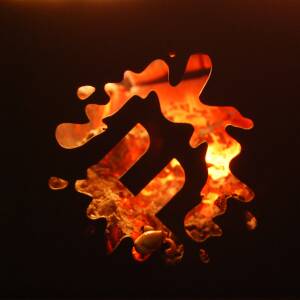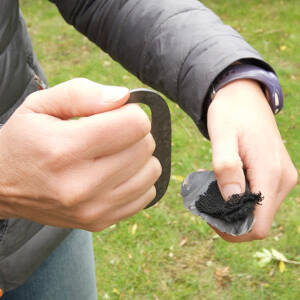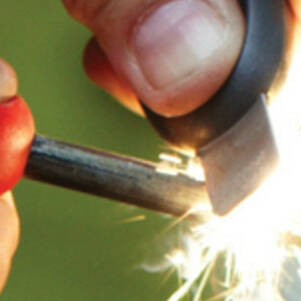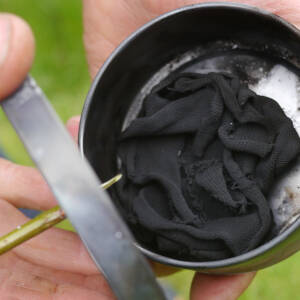Fires: how to use a fire steel
All you need to know about fire steels (ferrous rods) and some top tips on how to use them.
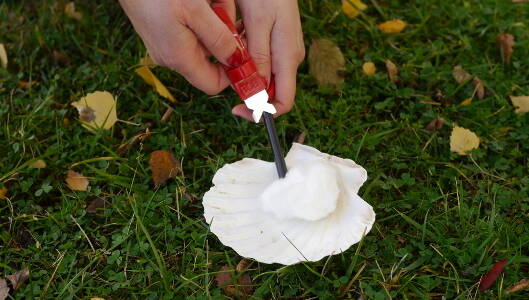
Introduction
Using a fire steel is fun for everyone and may require a bit of patience! We have put together some useful information and some tips to help you succeed.
What you'll need
- a ferrous rod fire steel and striker
- dry tinder: cotton wool/bullrush fluff/fine birch bark shavings/tinder fungus
- kindling and fuel
- a fire pit or vessel such as a tin plate or scallop shell
This activity has been provided by

Useful items from our shop
- Dragons Sneeze
- Scallop Shells
- Fire Starter Set
- Mini-Fire Starter Set
- Large Group Fire Starter Set
- Dragons Sneeze Fire Starter Set
Environmental Considerations
Consider the environmental impact of preparing, carrying out & completing this activity. Could this impact be reduced? Specific considerations for this activity could include:
- leave no trace
- source of kindling/fuel
Health & Safety Considerations
Follow your usual operating procedures and carry out appropriate risk benefit assessments.
Some considerations particular to this activity include:
What is a ferrous rod fire steel?:
The ferrous rod fire steel is a very engaging tool used to light fires in many different situations.
Ferrous rods and strikers have many different commercial and widely-recognised names such as: fire steels, fire flints, fire starters and our own Dragons Sneeze.
The name “flint-and-steel”, often given to these small ferrocerium rod tools, is technically incorrect. The name relates to the traditional fire lighting technique of striking a piece of flint (rock) with a metal striker. Ferrocerium has no relationship chemically to flint (rock). The association of names has originated due to both materials having been used in a similar way to create sparks to light fires.
Ferrous rods are made of ferrocerium, also known in Europe as Auermetall. The name ferrocerium comes from its main components: iron (ferrum) and cerium. Cerium is a highly elastic, rare earth metal, iron-grey in colour. Cerium has a low ignition temperature of between 150 and 180 °C (302 and 356 °F).
Ferrocerium is a synthetic alloy that is highly pyrophoric (capable of igniting spontaneously in air). During the striking process small shavings are removed at high speed, this oxidizes very quickly in contact with the air, the heat of the friction ignites the oxidized shavings and the burning metal is the spark.
Ferrocerium has been used in many different ways – it is commonly used in lighters and as fire lighters for survival, this is due to its ability to spark in adverse weather conditions.
How to choose?
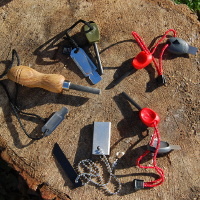
Often the choice of fire steel comes down to personal preference. There are a few things to consider:
How will the tool be held?
Many small fire steels have been designed to be lightweight and compact – ideal for survival situations. There are now fire steels on the market that have been specially designed for easier holding positions such as the Dragons Sneeze.
Quality of ferrous rods
This is normally represented in the price of the fire steel. If it looks the same size but is much cheaper it is likely that the quality of rod is not as good.
Often the bigger heavier rod steels are better value for money as they are normally twice as expensive as a smaller one of the same brand but could have up to three times as much ferrocerium material in them.
Exploring different kinds of ferrous rod fire steels:
Below we investigate the main designs of fire steels; looking at benefits and disadvantages with the aim of supporting you to choose the best one for your use.
Standard fire steel:
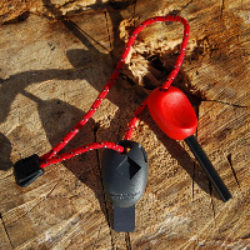
Most ferrous rod fire steels are designed in a similar way, where the rod is encased in a plastic pad at one end. This pad is held in a pincer grip between forefinger and thumb of the less dominant hand. The striker is also held in a pincer grip, by the dominant hand.
Benefits: they are small and compact making them ideal for travel and survival.
Disadvantages: this grip can be tricky to master for young children or anyone with any sort of dexterity issues.
Dragons Sneeze fire steel:
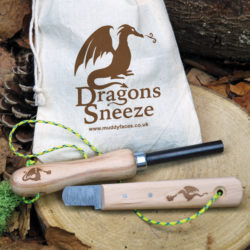
Our own specifically designed and created fire steel.
Benefits: this fire steel has been designed to overcome the dexterity difficulties that are associated with a standard steel. It has a large comfortable handle, for both the rod and the striker. The long connecting string offers freedom of movement, and a high quality ferrous rod and striker ensure successful results. Its size makes it easier to keep track of (less likely to lose).
This fire steel has a very high success rate for striking. Many leaders now only use Dragons Sneezes with their groups, or they always have one available in case an individual is struggling with a standard striker.
Disadvantages: it is not as small as other tools for situations where size and weight are critical.
It is a bigger investment than many standard steels, but essentially you are purchasing two separate tools. The striker can be used even after the rod has worn out.
Watch a video demonstration of making a spark using a Dragon's Sneeze here. Watch more Muddy Faces Dragon's Sneeze videos below.
How to use a ferrous rod fire steel:
Below are some tips and techniques to get the most from your fire steel.
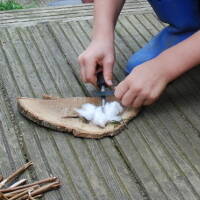
Step #1 Holding the striker and steel/rod
Place the tip of the rod into your tinder.
Position the blade of the striker over the rod with handles at right angles.
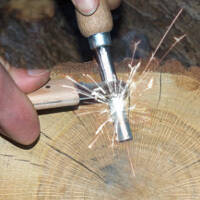
Step #2 Creating a spark
It helps to rest the base of the rod firmly in the tinder which should, ideally, be resting on a hard stable surface.
Scrape the striker down the rod in a long, firm stroke to create abundant sparks. Always use strokes moving away from the body and fingers to avoid cuts from the blade. Aim the sparks into the tinder and repeat these strokes until the tinder catches alight. Avoid quick flapping stokes as it often extinguishes a light that you haven’t had time to notice.
Depending on the type of tinder used the sparks will either cause the tinder to catch alight or will cause an ember to form in the tinder.
Tips:
If you struggle to get a spark, try altering the angle of the striker against the steel.
To prevent wearing out the middle part of the rod ensure you strike along the full length of the rod.
Hold the striker as close to the steel as possible and don’t be scared of the sparks!
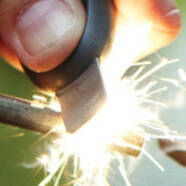
Step #3 Igniting
Use the spark to ignite the tinder or to create an ember.
See how to create & maintain a fire for tips on how to build and maintain a campfire.
Fire steels that require a different action are discussed below.
Vertical strike standard fire steels:
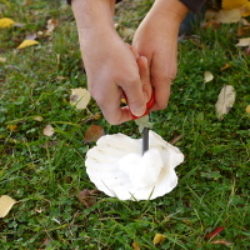
Some fire steels have a groove that allows a more vertical strike. The one pictured can be used in both ways.
Magnesium block:
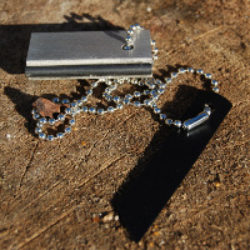
Magnesium burns at a very high temperature so is useful in wetter conditions. A magnesium block has a built in steel along one edge.
How to use:
- use the serrated edge of the striker to draw long strokes along the magnesium block on the opposite side to the flint
- scrape off curly pieces of magnesium
- collect magnesium on a piece of dry bark or a cotton wool pad
- sprinkle the shavings over the tinder or add tinder to the magnesium
- then use the metal striker down the small rod attached to the other side of the block. Frequently people use the serrated edge to strike with, which does create a good spark, but gouges the rod thus reducing the longevity.
Knife as striker:
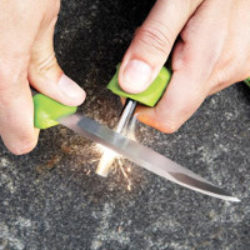
Often people use the back of their knife as the metal striker. This has the advantage of a nice chunky grip that generates effective sparks. Consequently you do not need to carry an additional striker if travelling light.
This technique is not often used with groups as the knife is used in a very exposed manner.
Dragon's Sneeze Video Collection:
Dragon's Sneeze Story
Dragon's Sneeze Interview
Starting a fire with a Dragon's Sneeze - a demonstration by Holly & Hawthorn Forest School, Shepton Mallet, Somerset.
Disclaimer: Muddy Faces cannot take any responsibility for accidents or damage that occurs as a result of following this activity.You are responsible for making sure the activity is conducted safely.
Key Features
- Age Range 3+
- Duration Less than an hour
- Location Anywhere
- Season Any
- Time of Day Anytime
-
Categories:
Fire, Shelters & Bushcraft
fire
Activity Downloads
